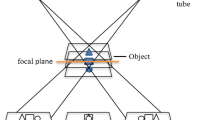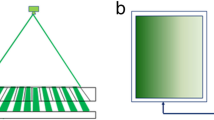Abstract
X-ray computed laminography (CL) is used in the fields of industrial inspection and medical imaging. It can provide the internal structure three-dimensional (3D) information of a region of the objects nondestructively. It is important to the clinical diagnosis and the quality control of flat objects like printed circuit boards, aircraft wings and satellite solar panels. With the restriction that the imaging region must be within the X-ray beam formed by the X-ray source and the detector, the imaging field of view of CL is limited by the size of detector. A new CL method with an asymmetric rotational cone-beam scanning geometry, called large field of view CL, is presented to overcome the existing disadvantage. It can extend the imaging region when the imaging spatial resolution keeps the same as that of the conventional CL. It can also improve the imaging spatial resolution when the imaging region keeps the same as that of the conventional CL. The asymmetric configuration can be achieved by offsetting the detector from the conventional symmetric configuration. It does not, however, require new detectors and X-ray source nor alter the scanning mechanical system. The filtered back-projection (FBP) reconstruction algorithm and the data truncation smoothing functions have been deduced to reconstruct the images directly from the data acquired with this asymmetric configuration. We performed numerical studies and experiments to demonstrate and validate the proposed approach. Results in these studies and experiments confirm that the proposed method can enlarge the imaging region and improve the spatial resolution. The proposed approach may find applications in the CL system with the rotational scanning geometry.
Similar content being viewed by others
References
Fu J, Lu H N. Beam-hardening correction method based on original sinogram for X-CT. Nucl Instrum Meth Phys Res A, 2006, 556:379–385
Fu J, Lu H N, Li B, et al. X-CT imaging method for large field objects using double offset scan mode. Nucl Instrum Meth Phys Res A, 2007, 575:519–523
Gondrom S, Schropfer S. Digital computed laminography and tomosynthesis-functional principles and industrial applications. Proceedings of International Symposium on Computed Tomography and Applications, Berlin, Germany, 1999
Wakimoto K, Blunt J, Carlos C. Digital laminography assessment of the damage in concrete exposed to freezing temperatures. Cemt Conc Res, 2008, 38:1232–1245
Plantes Z. Eine neue methode zur differenzierung in der rotgenographie. Acta Radio, 1932, 13:182–191
Dobbins J T, Godfrey D J. Digital X-ray tomosynthesis: current state of the art. Phys Med Biol, 2003, 48:R65–R106
Ewert U, Robbel J, Nockemann C H, et al. Digital laminography. International Symposium on Computerized Tomography for Industrial Applications, DGZfP Berichtsband, Berlin, Germany, 1994, 44:148–159
Feiste K, Stegemann D, Reimcke W, et al. Three-dimensional analysis of growing casting defects. International Symposium on Computerized Tomography for Industrial Applications, DGZfP, Berichtsband, Berlin, Germany, 1994, 44:160–169
Tuy H K. An inversion formula for cone-beam reconstruction. SIAM J Appl Math, 1983, 43:546–552
Smith B D. Image reconstruction from cone-beam projection: necessary and sufficient condition and reconstruction methods. IEEE Trans Med Imag, 1985, 4(1):14–25
Zhou J, Maisl M, Reiter H, et al. Computed laminography for materials testing. Appl Phys Lett, 1996, 68(24):3500–3502
Gondrom S, Zhou J, Maisl M, et al. X-ray computed laminography: an approach of computed tomography for applications with limited access. Nucl Eng Design, 1999, 190:141–147
Moore T D, Vanderstraeten D, Forssell P M, et al. Three-dimensional X-Ray laminography as a tool for detection and characterization of BGA package defects. IEEE Trans Compon Packag Technol, 2002, 25(2):224–229
Ewert U, Baranov A V, Borchardt K, et al. Cross-sectional imaging of building elements by new non-linear tomosynthesis techniques using imaging plates and Co-60 radiation. NDT NDE Intl, 1997, 30(4):243–248
Hsieh J. Computed Tomography—Principles, Designs, Artifacts, and Recent Advances. Bellingham, WA: SPIE, 2003
Delaney H, Brelser Y. Globally convergent edge-preserving regularized reconstruction: an application to limited-angle tomography. IEEE Trans Image Processing, 1998, 7:204–221
Andersen H. Algebraic reconstruction in CT from limited views. IEEE Trans Med Imag, 1989, 8:50–55
Parker D L. Optimal short-scan convolution reconstruction for fan-beam CT. Med Phys, 1982, 9:254–257
Author information
Authors and Affiliations
Corresponding author
Rights and permissions
About this article
Cite this article
Fu, J., Jiang, B. & Li, B. Large field of view computed laminography with the asymmetric rotational scanning geometry. Sci. China Technol. Sci. 53, 2261–2271 (2010). https://doi.org/10.1007/s11431-010-4012-6
Received:
Accepted:
Published:
Issue Date:
DOI: https://doi.org/10.1007/s11431-010-4012-6




